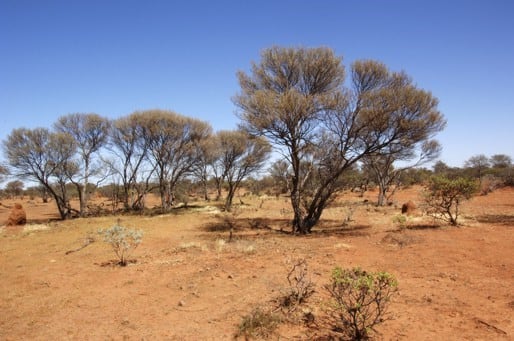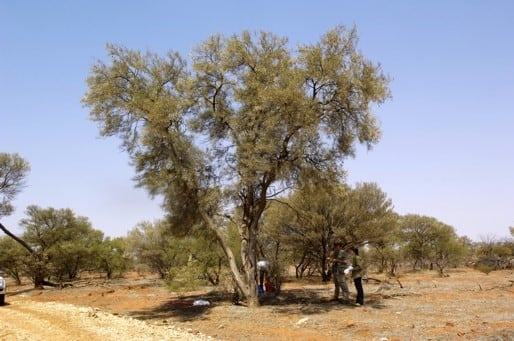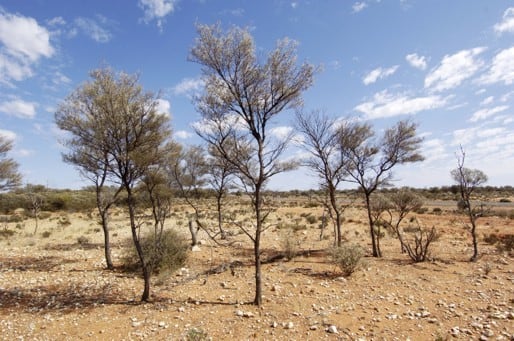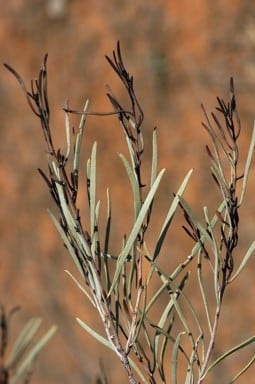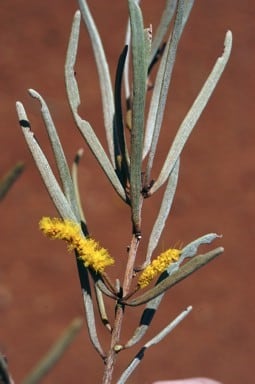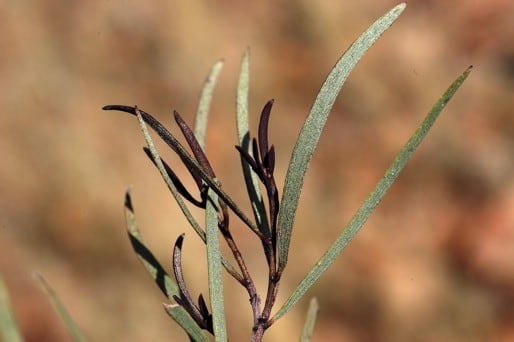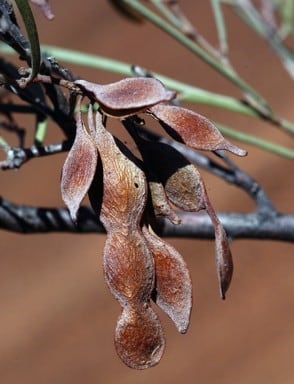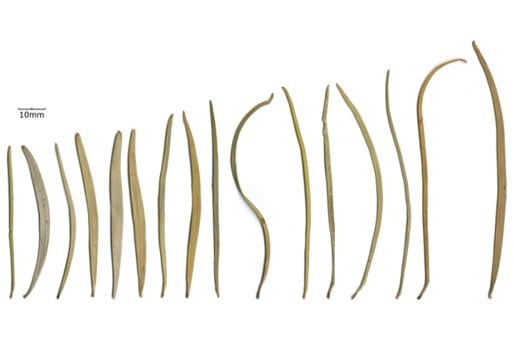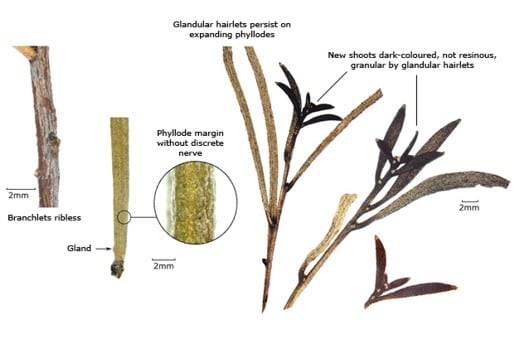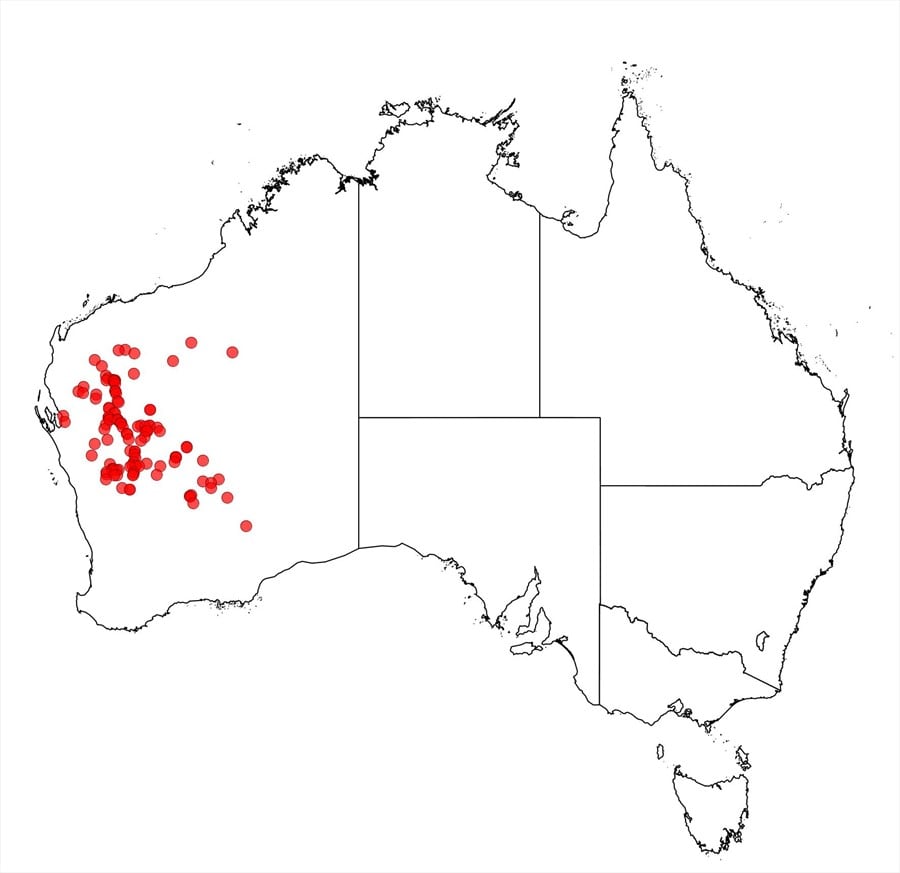Acacia fuscaneura Maslin & J.E.Reid
WATTLE
Acacias of Australia
Common Name
Sooty Mulga
Family
Fabaceae
Distribution
Endemic in W.A. where it extends from the Pilbara region S to Paynes Find and E to near Wiluna and Laverton; an outlier occurs on Carbla Stn in the Shark Bay district.
Description
Obconic tree 3–8 (–10) m high sometimes with a pseudo-conifer (adolescent plants) or rarely a conifer growth form. Bark charcoal grey to blackish. Branchlets obscurely ribbed or ribless, ribs normally not resinous; new shoots not resinous, with a dense layer of dark-coloured (often blackish) glandular hairlets that persist (becoming scattered) as shoot expands and imparting a fine, granular appearance to the young phyllodes and branchlets. Phyllodes sub-straight to shallowly curved, sigmoid or wavy, narrowly linear or sometimes narrowly elliptic, not rigid, flat, 5–10 (–12) cm long, 1–3 (–5) mm wide, green to grey-green (often sub-glaucous when young), finely multistriate with obscure appressed hairs between the nerves, margins normally not resinous; gland normally 0–2 mm above pulvinus. Inflorescences simple; peduncles (4–) 5–12 (–15) mm long. Flowers 5-merous; sepals free or shortly united at base, ⅓–½ length of petals, oblong to narrowly oblong; petals 1.3–1.5 mm long. Pods oblong to narrowly oblong, mostly shallowly to moderately constricted between the seeds, (1–) 2–5(–6.5) cm long, (6–) 8–13 mm wide including wings (when present), thinly coriaceous, commonly greyish brown but often tinged purplish, minutely appressed white-hairy, not resinous, obscurely reticulate; margins bevel-edged, rarely with wing 1 mm wide. Seeds longitudinal to oblique or transverse, 4–7 (–8) mm long, (3–) 4–6 mm wide, discoid to widely elliptic or sometimes oblong, flattened; aril small, ±white.
Habitat
Grows in sand, loam or clay on stony plains or in skeletal soil on low rocky hills of mixed geology, and is commonly associated with water courses; in open to dense Mulga and/or mixed Acacia shrubland.
Specimens
W.A.: 5 km W of Erong Springs HS, R.J.Cranfield 5345 (PERTH, Z); Lennonville, c. 10 km N of Mt Magnet, B.R.Maslin 3585 (PERTH); Balfour Downs Stn, B.R.Maslin 8873 (PERTH); 10 km due ESE of Mt Magnet, Boogardie Stn, `Mullitor paddock', B.R.Maslin, et al. BRM 7897E (BRI, CANB, KPBG, PERTH); Woodleigh-Byro [stations] turn-off, North West Coastal Hwy, G.Phillips for A.M.Ashby AMA 4493 (AD, HO, MEL, PERTH).
Notes
A member of the ‘A. aneura group’ (Mulga) most closely related to A. pteraneura and A. aneura both of which possess resinous new shoots. Acacia fuscaneura is sometimes sympatric with A. pteraneura and intergrades/hybrids between them occur in a few populations. Acacia pteraneura is further distinguished by its terete to subterete phyllodes and never bevel-edged pods; however, some specimens cannot be satisfactorily accommodated in either species, see B.R.Maslin & J.E.Reid, Nuytsia 22(4): 129–267 (2012), for discussion. Acacia aneura is further distinguished by its pods that are more thinly textured, ±glabrous, never purple-tinged, mostly straight-edged with resinous margins and normally smaller seed.
Genetically A. fuscaneura is related to A. macraneura but morphologically the two species are very dissimilar, see B.R.Maslin & J.E.Reid, loc. cit., for discussion. Acacia fuscaneura occasionally putatively hybridizes with A. ramulosa (e.g. B.R. Maslin et al.) and rarely with A. incurvaneura (e.g. B.R. Maslin et al. BRM 9149), see B.R.Maslin and J.E.Reid, loc. cit., for discussion.
This taxon was treated as A. aneura var. fuliginea by L.Pedley, Fl. Australia 11B: 322 (2001), but B.R.Maslin & J.E.Reid, loc. cit., consider it warrants recognition as a distinct species.The specimens A.W. Humphries M31 and M. Kerkhoff s.n. that L.Pedley, loc. cit., cited under A. aneura var. fuliginea are hybrids involving A. craspedocarpa, while the J.W.Green 1625 specimen that was also cited under var. fuliginea is hybrid of uncertain parentage, see B.R.Maslin and J.E.Reid, loc. cit., for discussion.
A characteristic feature of A. fuscaneura is that its new shoots are not resinous and are dark-coloured (often blackish) due to a very dense layer of glandular hairlets that tend to persist (but are less dense) as shoot expands, giving it the appearance of being covered by a sooty substance. Its pod margins can be either bevel-edged or less commonly winged; as discussed by R.Rutishauser et al., Phyton 50: 69-89 (2010), the bevel-edge is interpreted as a highly reduced wing.
FOA Reference
Data derived from Flora of Australia Volumes 11A (2001), 11B (2001) and 12 (1998), products of ABRS, ©Commonwealth of Australia
Author
B.R.Maslin
L.Pedley
This identification key and fact sheets are available as a mobile application:
URL: https://apps.lucidcentral.org/wattle/
© Copyright 2018. All rights reserved.

